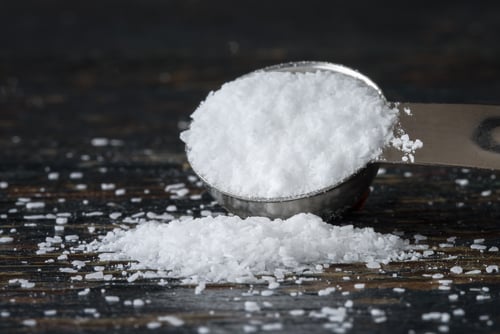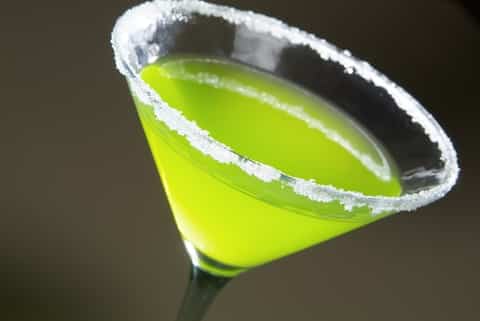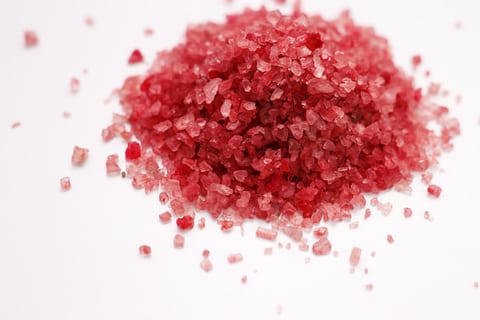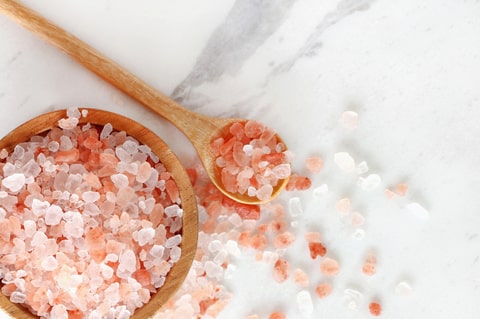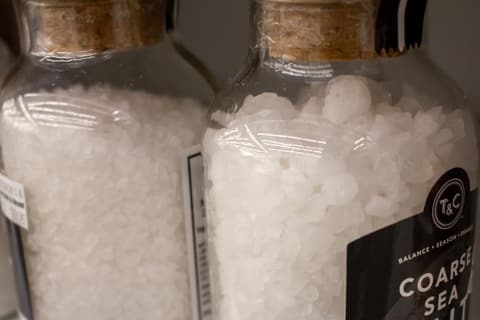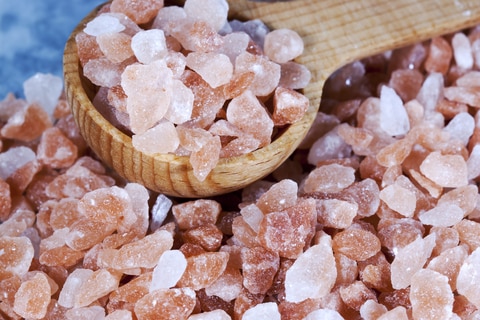
Pretzel salt (also called food-grade coarse salt) is a large-grained salt used widely for making pretzels and salted breadsticks.
The distinctive quality of this salt is that it does not melt during baking, making it a perfect topping for when you want to brown pretzels without melting the salt.
The crystals of pretzel salt are of uniform size, having a rectangular and flat shape. The salt flakes contain no additives and have an enhanced ability to adhere to baked goods such as focaccia, bread, or hard rolls and pretzels.
Pretzel salt is less refined compared to table salt; it contains minerals that are usually removed from table salt. You can use this salt in coarse rubs for salt-crusted fish, for curing different types of meat, and for zucchini fritters.
Pretzel Salt Substitutes
If your recipe calls for pretzel salt, but you don’t have it on hand, then you can go for some of the substitutes we’ve mentioned below.
Some of the substitutes we’ve mentioned also melt while cooking, so if you have a recipe or dish that doesn’t need visible flakes, you can try those out. You don’t have to worry about any taste difference, though the texture or appearance might be different.
1. Kosher Salt
Arguably the best alternative on this list, kosher salt has a striking resemblance to pretzel salt due to its granular form. It’s a coarse-grained salt assembled from salt crystals, hence why its appearance is so similar to pretzel salt.
The shape of kosher salt is determined by the evaporation process. Its shape ranges from flat to pyramidal in structure. Another similarity between the two salts is that neither of them contains any additives.
Like most salts used in cooking, Kosher mainly contains sodium chloride. Kosher grains can be easily picked on your hands, so you control the quantity of salt added and can even add it in a specific plating style for presentation.
A great thing about Kosher salt is that it enhances the flavor of food, especially when paired with something sweet like bread, baked goodies, chocolate, caramel, etc, rather than simply making the food taste salt, enhances the taste of food by improving the flavor rather than just making it taste salty.
Typically, Kosher salt is added for koshering meat, as well as canning, brining, rubbing, and marinating. Kosher salt is also excellent for rimming drinks like margaritas and can look gorgeous in plating.
Plus, Kosher salt doesn’t melt easily in the oven, much like pretzel salt.
2. Margarita Salt
Another substitute for pretzel salt is margarita salt. While it’s usually used to coat the rims of margarita glasses, it can be used in cooking.
The salt is available in different dyed colors. The use of dye may change the taste of the recipe slightly, so it’s recommended that you check what option you’re choosing to get the best alternative for pretzel salt in your recipes.
You don’t want the salt interfering with your dish’s taste. That being said, most margarita salts taste similar to pretzel salt. And don’t worry- the dye isn’t so concentrated as to completely change the color of what you’ve made.
3. Red Diamond Sea Salt
Next up on the list is the Red Diamond sea salt. This one has a stark white appearance because of its harsh refining process. It is a crushed sea salt that is extracted from deep within the earth.
The unique flecks of the color of this salt are mainly due to the presence of 50 natural traces of minerals. These are essential for humans (e.g Iodine).
Red Diamond sea salt has a mild flavor and doesn’t overpower any dish with saltiness. It contains various additives like dextrose, silicates, etc, too. It melts quite well and can form a crust when melted and burnt.
All in all, you can use Red Diamond sea salt as an excellent alternative to pretzel salt.
4. Rock Salt
Rock salt is a type of salt that is formed when the saltwater of the sea or lake evaporates, so the colorful crystals of sodium chloride are left behind. Rock salt is a combination of several minerals like zinc, nickel, cobalt, copper, and manganese.
These minerals give rock salt its distinct colors. The addition of rock salt in food will help in avoiding low sodium levels that cause poor sleep and seizures.
5. Morton Salt
Morton salt is composed of calcium silicate, sugar, sea salt, and potassium iodide. Iodized Morton salt supplies iodine which is essential for the appropriate functioning of the thyroid.
You can use Morton salt in your recipes to substitute pretzel salt. It’s a relatively healthy option, though the quantity of mineral nutrition you’re getting from it isn’t balanced.
6. Coarse Sea Salt
Pretzel salt and coarse sea salt are both large-grained salts with visible flakes. However, coarse sea salt is more often used to salt meat, in the preparation of brine, and in regular recipes such as soups, sauces, etc.
One important thing to notice about coarse sea salt is that it is much saltier than other kinds of salt. Therefore, you have to be careful while using it- start by adding a few quantities and then adding more amounts according to your taste.
As this salt is more concentrated, it doesn’t dissolve as easily. However, it’s more prone to melting than basic pretzel salt.
Coarse sea salt keeps us hydrated due to the presence of several nutrients that are present in it. These nutrients help in satisfying the thirst for longer periods.
This salt is a good source of the electrolytes such as calcium, magnesium, sodium, and potassium. These electrolytes are essential for the muscle, brain, and heart health of humans. Health experts recommend coarse sea salt for all types of fatigues too.
7. Bagel Salt
It is composed of pure-formed sea salt crystals. Bagel salt adds a delicious salty taste which elevates the bread-like flavor of bagels and pretzels. It also pairs well with French fries.
You can substitute this bagel salt in place of pretzel salt. The baked goods made up using bagel salt are delicious and subtle. If you’re going to eat pretzels or bagels with pink salt on top, try adding ingredients like cream cheese to balance the flavors out.
8. Himalayan Pink Salt
Last on the list is Himalayan pink salt, a salt mainly composed of sodium chloride but containing minerals like calcium, potassium, and magnesium. It’s a relatively healthier option.
However, do keep in mind that it will have less iodine than the refined and iodized white salts. The distinct light-pink color looks great when used on rims of drinks.
Pink salt is available in many forms including small granules similar to table salt, powder, and larger flakes that resemble pretzel salts. This salt is less artificial and has no anti-caking agents (which are usually present in table salt to prevent caking).
How To Add Salt To Pretzels
If you have unsalted pretzels and want to add some delicious pretzel salt substitute on top, simply wet the pretzel, either by pouring a little bit of water on it, running it under a tap, or using your fingers to moisten the snack.
Then grab a pinch of your favorite salt and sprinkle. Once done, bake it as per instructions.
The Bottom Line
You can try one of the above pretzel salt substitutes for your recipes. The substitutes will give a good taste if the right amount of substitute salt is added. Some salts are stronger in flavor and more concentrated, like the coarse sea salt, while others are milder (like Kosher salt).
Finding the right quantity for your recipe requires some trial and error. But as a general rule, remember that any iodized salt is much saltier in flavor than naturally extracted salts with no additives. Remember that to make the best pretzels, you must get the baking right.

